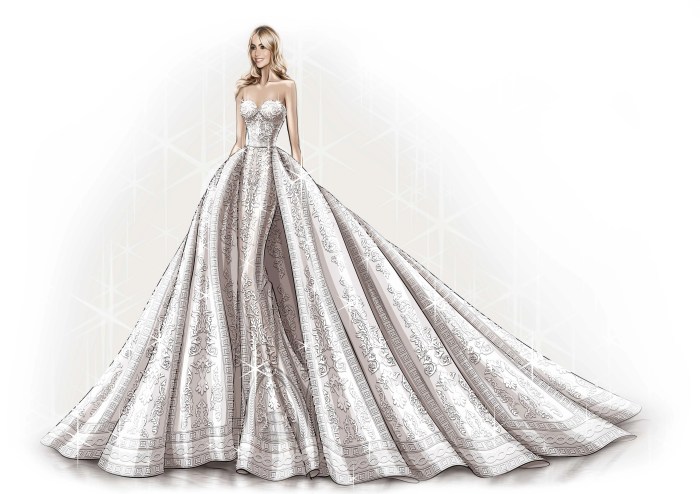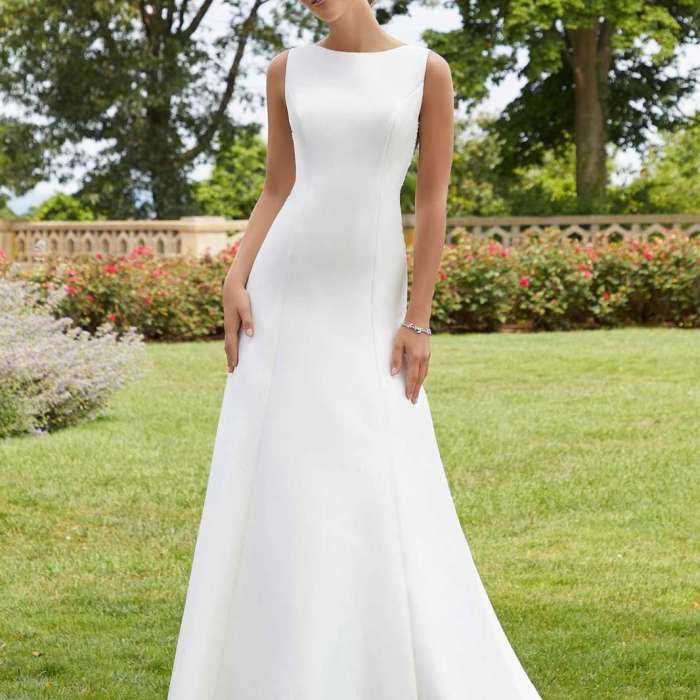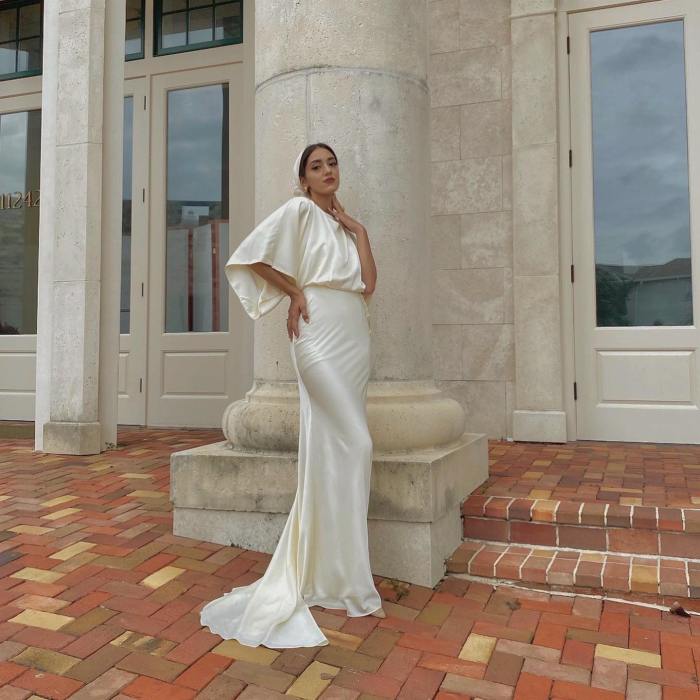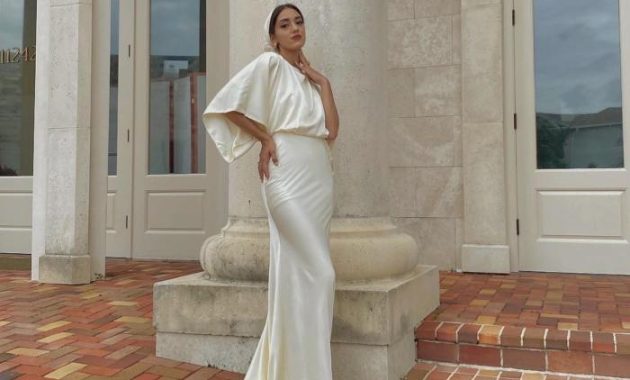Defining “Classic” in Wedding Dress Design: Classic Wedding Dress Designers
Classic wedding dress designers – The term “classic” in wedding dress design evokes timeless elegance and enduring style. It transcends fleeting trends, representing silhouettes, fabrics, and embellishments that consistently resonate across generations. Understanding what constitutes a classic wedding dress requires examining its evolution through the decades and identifying the core elements that set it apart from contemporary styles.
Evolution of Classic Wedding Dress Styles

Source: vogue.com
The classic wedding dress has undergone subtle yet significant transformations over time, reflecting changing social norms and fashion sensibilities. The following table illustrates this evolution.
| Decade | Defining Characteristics | Prominent Designers | Notable Examples |
|---|---|---|---|
| 1920s | Dropped waistlines, loose silhouettes, beaded embellishments | Madeleine Vionnet | Sheath dresses with subtle embellishments |
| 1930s | Bias-cut gowns, long sleeves, sleek lines | Elsa Schiaparelli | Elegant, form-fitting gowns with minimal embellishment |
| 1940s | Full skirts, fitted bodices, shoulder pads | Christian Dior | A-line silhouettes with cinched waists |
| 1950s | Full skirts, cinched waists, petticoats | Vera Wang | Ballgown silhouettes with elaborate details |
| 1960s | A-line silhouettes, simple designs, minimal embellishments | Yves Saint Laurent | Simple, elegant gowns with clean lines |
| 1970s | Bohemian styles, lace, embroidery | Oscar de la Renta | Flowing gowns with romantic details |
| 1980s | Large, dramatic silhouettes, puffy sleeves, elaborate details | Carolina Herrera | Gowns with structured silhouettes and opulent details |
| 1990s | Simple silhouettes, minimalist designs | John Galliano | Clean lines and simple embellishments |
| 2000s – Present | Varied styles, but classic elements like lace and clean lines persist | Monique Lhuillier | A blend of classic and contemporary elements |
Enduring Elements of Classic Wedding Dresses
Classic wedding dresses share several enduring elements that distinguish them from contemporary trends. While modern designs often embrace avant-garde silhouettes and unconventional fabrics, classic gowns prioritize timeless elegance and refined simplicity. This is achieved through a focus on high-quality fabrics, meticulous craftsmanship, and carefully considered silhouettes.
A classic wedding dress often features a clean silhouette, such as an A-line, empire waist, or sheath. These styles flatter a variety of body types and remain visually appealing across time. In contrast, contemporary designs often experiment with asymmetrical hems, dramatic trains, and unconventional necklines.
Classic vs. Modern Wedding Dress Silhouettes: A Visual Comparison, Classic wedding dress designers
Imagine two side-by-side illustrations. On the left, a classic A-line gown with a fitted bodice and a full skirt falling gracefully to the floor. The fabric is a luxurious satin, and the only embellishment is delicate lace at the neckline and waist. The overall impression is one of understated elegance and timeless sophistication. On the right, a modern gown features a high slit, a dramatic asymmetrical hem, and intricate beading.
The fabric is a textured crepe, and the silhouette is less structured, more fluid and free-flowing. The modern gown embodies a more contemporary aesthetic, prioritizing bold design choices and individual expression.
Iconic Classic Wedding Dress Designers
Several designers have consistently championed classic wedding dress aesthetics, shaping the industry’s understanding of timeless elegance. Their contributions have significantly influenced contemporary designs.
- Vera Wang
- Carolina Herrera
- Oscar de la Renta
- Monique Lhuillier
- Claire Pettibone
Signature Styles and Design Philosophies
Each designer brings a unique perspective to classic wedding dress design. Vera Wang, known for her modern interpretations of classic silhouettes, often incorporates unexpected details, such as dramatic trains or unconventional necklines. Carolina Herrera, on the other hand, embodies sophisticated simplicity, prioritizing clean lines and luxurious fabrics. Oscar de la Renta’s designs are characterized by romantic details, such as lace and embroidery, while Monique Lhuillier blends classic elegance with modern sensibilities, creating gowns that are both timeless and contemporary.
Claire Pettibone’s designs lean towards a romantic, bohemian aesthetic, incorporating vintage-inspired details and luxurious fabrics.
Comparing Vera Wang and Carolina Herrera
While both Vera Wang and Carolina Herrera are celebrated for their classic designs, their approaches differ significantly. Wang often incorporates unexpected elements and modern twists into classic silhouettes, creating gowns that are both timeless and contemporary. Herrera, conversely, prioritizes clean lines and minimalist designs, emphasizing the quality of the fabric and the impeccable tailoring. Both designers have contributed significantly to the evolution of classic wedding dress design, but their distinct styles reflect their individual design philosophies.
Key Design Elements of Classic Wedding Dresses
Several key design elements consistently appear in classic wedding gowns, contributing to their timeless appeal. These elements are carefully chosen to create a sense of refined elegance and enduring style.
Classic Wedding Dress Fabrics
Classic wedding dresses frequently utilize high-quality fabrics known for their luxurious drape and enduring beauty. These include:
- Silk: Known for its luxurious drape and sheen, silk is a popular choice for classic wedding gowns.
- Satin: A smooth, lustrous fabric that adds elegance and sophistication.
- Lace: A delicate and intricate fabric that adds a touch of romance and femininity.
- Tulle: A sheer, netting-like fabric often used for full skirts and veils.
- Organza: A crisp, sheer fabric that adds volume and texture.
Lace, Embroidery, and Beading
These embellishments elevate classic wedding gowns, adding intricate detail and visual interest.
Classic wedding dress designers often inspire the overall aesthetic of a wedding. The bride’s choice of gown, perhaps a timeless design from a renowned house, heavily influences the selection of bridesmaid dresses. For example, a blush wedding dress might pair beautifully with a range of complementary shades, as seen in options for bridesmaid dresses with blush wedding dress.
Ultimately, the cohesive vision reflects the bride’s personal style and the enduring legacy of classic designers.
- Lace: Adds a touch of romance and femininity, ranging from delicate chantilly lace to heavier Alençon lace.
- Embroidery: Provides intricate detailing, often incorporating floral motifs or geometric patterns.
- Beading: Adds sparkle and glamour, ranging from subtle seed beads to larger, more dramatic embellishments.
Classic Wedding Dress Necklines
| Neckline | Description | Suitable Body Types | Example Designer |
|---|---|---|---|
| Sweetheart | Heart-shaped neckline | Most body types | Vera Wang |
| V-neck | V-shaped neckline | Most body types, especially those with long necks | Carolina Herrera |
| Bateau | Boat-shaped neckline | Those with broader shoulders | Oscar de la Renta |
| High Neck | Neckline that sits high on the neck | Those with slender necks | Monique Lhuillier |
The Influence of Classic Wedding Dress Designers on Modern Styles
The legacy of classic designers continues to inspire contemporary wedding dress design. Modern designers frequently reinterpret classic elements, blending timeless elegance with modern sensibilities. This results in gowns that honor tradition while embracing contemporary aesthetics.
Reinterpreted Classic Design Elements
Many classic design elements are regularly reinterpreted in modern collections. For example, the classic A-line silhouette is frequently updated with modern twists, such as asymmetrical hems or unique fabric choices. Lace, a staple of classic wedding dresses, remains a popular embellishment, often appearing in unexpected ways, such as on sleeves or as a unique overlay. Similarly, beading and embroidery continue to be used to add intricate details to contemporary gowns.
Classic vs. Modern Design: A Visual Comparison
Consider a classic 1950s A-line gown with a fitted bodice, full skirt, and delicate lace detailing. Now, imagine a modern interpretation: a contemporary A-line gown with a similar silhouette but featuring a unique neckline, a subtle train, and modern lace appliqués. The modern gown retains the essential elements of the classic design but incorporates contemporary details, creating a fresh and updated look.
Preservation and Appreciation of Classic Wedding Dress Designs

Source: brides.com
Preserving and appreciating classic wedding dress designs ensures that these pieces of history remain accessible for future generations. This involves careful storage, maintenance, and a recognition of their cultural significance.
Preserving Vintage Wedding Dresses

Source: cliqueinc.com
- Store in a cool, dry, and dark place, ideally in an acid-free archival box.
- Avoid direct sunlight or exposure to extreme temperatures or humidity.
- Have the dress professionally cleaned and preserved by a specialist.
- Use acid-free tissue paper to prevent creasing and yellowing.
- Regularly inspect the dress for any signs of damage or deterioration.
Cultural Significance and Resources
Classic wedding dresses hold significant cultural value, reflecting evolving social norms and fashion trends. They serve as tangible reminders of past eras and the traditions surrounding marriage.
- The Metropolitan Museum of Art Costume Institute
- The Victoria and Albert Museum
- Fashion archives at various universities and design schools
- Private collections and vintage clothing stores
Quick FAQs
What makes a wedding dress “classic”?
Classic wedding dresses often feature timeless silhouettes, high-quality fabrics like silk or lace, and elegant detailing that transcends fleeting trends. They emphasize clean lines, sophisticated embellishments, and a focus on enduring elegance.
Where can I find vintage wedding dresses?
Vintage wedding dresses can be found at antique shops, online marketplaces (like Etsy), consignment stores specializing in bridal wear, and even some vintage clothing boutiques.
How can I preserve my classic wedding dress?
Professional cleaning and preservation by a specialist is recommended. They can properly clean, repair, and store the gown to protect it from damage and ensure its longevity.
Are classic wedding dresses suitable for all body types?
While some classic silhouettes may be more flattering on certain body types, skilled alterations can adapt many classic designs to fit a wide range of figures. Consulting with a bridal stylist can help determine the most flattering options.

